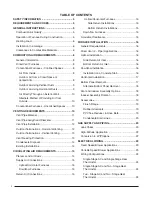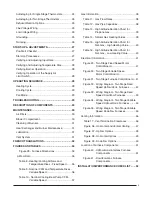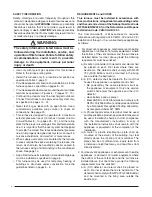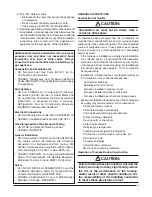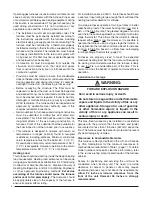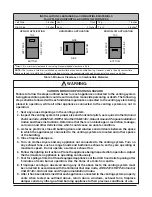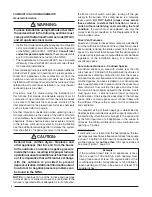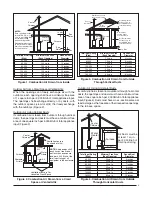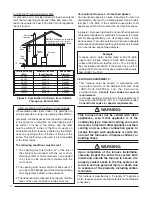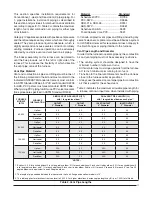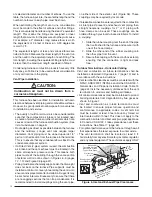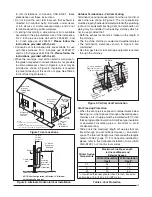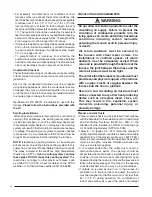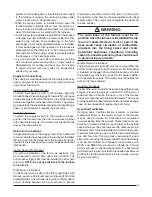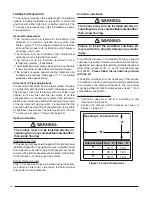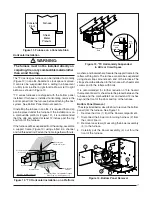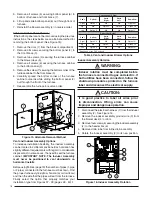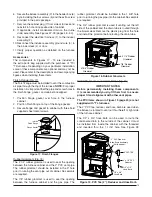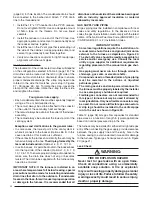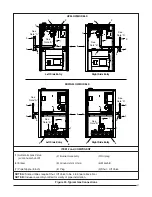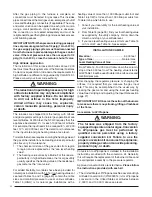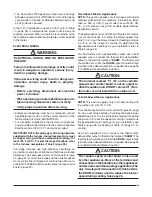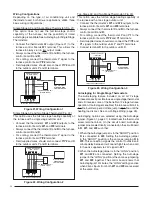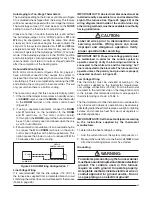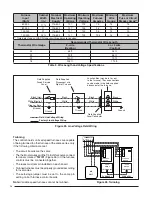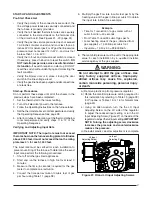
12
Figure 6. Inlet and Exhaust Pipe Clearances
12" Min.
to Maxim
um
Expected Sno
w Le
vel
Typical Both Pipes
36" max.
8" min.
Exhaust V
ent
Right Side Option
Mounting Kit
Faceplate Secured
to Wall with Screws
Typical Both Pipes
Combustion
Air Inlet
Inlet Exhaust
Both Sides
Exhaust Vent
Left Side Option
90°
Elbo
w
of selected diameter and number of elbows. To use the
table, the furnace input rate, the centerline length and the
number of elbows on each pipe must be known.
When estimating the length of vent runs, consideration
must be made to the effect of elbows and other fi ttings.
This is conveniently handled using the idea of “equivalent
length”. This means the fi ttings are assigned a linear
length that accounts for the pressure drop they will cause.
For example: a 2” diameter, long radius elbow is worth
the equivalent of 2.5 feet of linear run. A 90 degree tee
is worth 7 ft.
The equivalent lengths of tees and various elbows are
listed in Table 2. Measure the linear length of the vent run
and then add in the equivalent length of each fi tting. The
total length, including the equivalent fi tting lengths, must
be less than the maximum length specifi ed in Table 2.
Condensing furnace combustion products have very little
buoyancy, so Table 2 is to be used without consideration
of any vertical rise in the piping.
Vent Pipe Installation
CAUTION:
Combustion air must not be drawn from a
corrosive atmosphere.
This furnace has been certifi ed for installation with zero
clearance between vent piping and combustible surfaces.
However, it is good practice to allow space for convenience
in installation and service.
• The quality of outdoor air must also be considered. Be
sure that the combustion air intake is not located near
a source of solvent fumes or other chemicals which can
cause corrosion of the furnace combustion system. (See
list of substances on page 5).
• Route piping as direct as possible between the furnace
and the outdoors. Longer vent runs require larger
diameters. Vent piping must be sloped upwards 1/4”
per foot in the direction from the furnace to the terminal.
This is to ensure that any condensate fl ows back to the
condensate disposal system.
• If a Direct Vent (2-pipe) system is used, the combustion
air intake and the vent exhaust must be located in the
same atmospheric pressure zone. This means both
pipes must exit the building through the same portion
of exterior wall or roof as shown in Figures 6 - 9 (pages
12 - 13) and Figure 36 (page 47).
• Piping must be mechanically supported so that its weight
does not bear on the furnace. Pipe supports must be
installed a minimum of every 5 feet along the vent run to
ensure no displacement after installation. Supports may
be at shorter intervals if necessary to ensure that there
are no sagging sections that can trap condensate. It is
recommended to install couplings along the vent pipe,
on either side of the exterior wall (Figure 36). These
couplings may be required by local code.
• If breakable connections are required in the combustion
air inlet pipe (if present) and exhaust vent piping, then
straight neoprene couplings for 2” or 3” piping with
hose clamps can be used. These couplings can be
ordered through your local furnace distributor. To install
a coupling:
1. Slide the rubber coupling over the end of the pipe
that is attached to the furnace and secure it with
one of the hose clamps.
2. Slide the other end of the rubber coupling onto
the other pipe from the vent.
3. Secure the coupling with the second hose clamp,
ensuring that the connection is tight and leak
free.
Outdoor Terminations - Horizontal Venting
Vent and combustion air intake terminations shall be
installed as depicted in Figures 6 & 7 (page 13) and in
accordance with these instructions:
• Vent termination clearances must be consistent with the
NFGC, ANSI 2223.1/NFPA 54 and/or the CSA B149.1,
Natural Gas and Propane Installation Code. Table 15
(page 44) lists the necessary distances from the vent
termination to windows and building air intakes.
• All minimum clearances must be maintained to protect
building materials from degradation by fl ue gases as
shown in Figure 7.
• Vent and combustion air intake terminations must
be located to ensure proper furnace operation and
conformance to applicable codes. A vent terminal
must be located at least 3 feet above any forced air
inlet located within 10 feet. This does not apply to the
combustion air inlet of a direct vent (two pipe) appliance.
In Canada, CSA B149.1, takes precedence over these
instructions. See Table 17 (page 46).
• For optimal performance, vent the furnace through a wall
that experiences the least exposure to winter winds
.
• The vent termination shall be located at least 3 ft.
horizontally from any electric meter, gas meter, regulator
and any relief equipment. These distances apply ONLY


